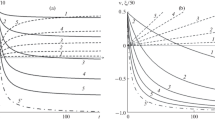Abstract
A four-parameter Maxwell model is formulated with fractional derivatives of different orders of the stress and strain using the Riemann-Liouville definition. This model is used to determine the relaxation and retardation functions. The relaxation function was found in the time domain with the help of a power law series; a direct solution was used in the Laplace domain. The solution can be presented as a product of a power law term and the Mittag-Leffler function. The retardation function is determined via Laplace transformation and is solely a power law type.
The investigation of the relaxation function shows that it is strongly monotonic. This explains why the model with fractional derivatives is consistent with thermodynamic principles.
This type of rheological constitutive equation shows fluid behavior only in the case of a fractional derivative of the stress and a first order derivative of the strain. In all other cases the viscosity does not reach a stationary value.
In a comparison with other relaxation functions like the exponential function or the Kohlrausch-Williams-Watts function, the investigated model has no terminal relaxation time. The time parameter of the fractional Maxwell model is determined by the intersection point of the short- and long-rime asymptotes of the relaxation function.
Similar content being viewed by others
References
Slonimski GL (1967) J Polym Sci C 16:1667–1673
Smit W, de Fries H (1970) Rheol Acta 9:525–534
Bagley RL, Torvik PJ (1983) J Rheol 27:201–210
Rogers L (1983) J Rheol 27:351–372
Vanarsdale WE (1985) J Rheol 29:851–857
Bagley RL, Torvik PJ (1986) J Rheol 30:133–135
Friedrich C, Heymann L (1988) J Rheol 32:235–241
Friedrich C, Heymann L, Berger H-R (1989) Rheol Acta 28:535–539
Tschoegl NW (1989) The Phenomenological Theory of Linear Viscoelastic Behavior — An Introduction. Springer, Berlin Heidelberg New York
Oldham KB, Spanier J (1974) The Fractional Calculus. Academic Press, New York and London
Westbrook PA, Follers JF (1987) Phil Mag A 55:253–268
Korn GA, Korn TM (1968) Mathematical Handbook. McGraw Hill, New York
Bateman H (1955) Higher Transcendental Functions, vol III. McGraw Hill, New York
Rabotnov JN (1977) Elements of the Mechanics of Memorysolids. Nauka, Moscow (in Russian)
Stastna J, De Kee M, Schummer P, Otten B (1990) Rheol Acta 29:137–144
Astarita G, Marrucci G (1974) Principles of Non-Newtonian Fluid Mechanics. McGraw Hill, London New York
Friedrich C (1991) to appear in Lecture Notes in Physics. Springer, Berlin Heidelberg New York
Author information
Authors and Affiliations
Rights and permissions
About this article
Cite this article
Friedrich, C. Relaxation and retardation functions of the Maxwell model with fractional derivatives. Rheola Acta 30, 151–158 (1991). https://doi.org/10.1007/BF01134604
Received:
Revised:
Issue Date:
DOI: https://doi.org/10.1007/BF01134604




